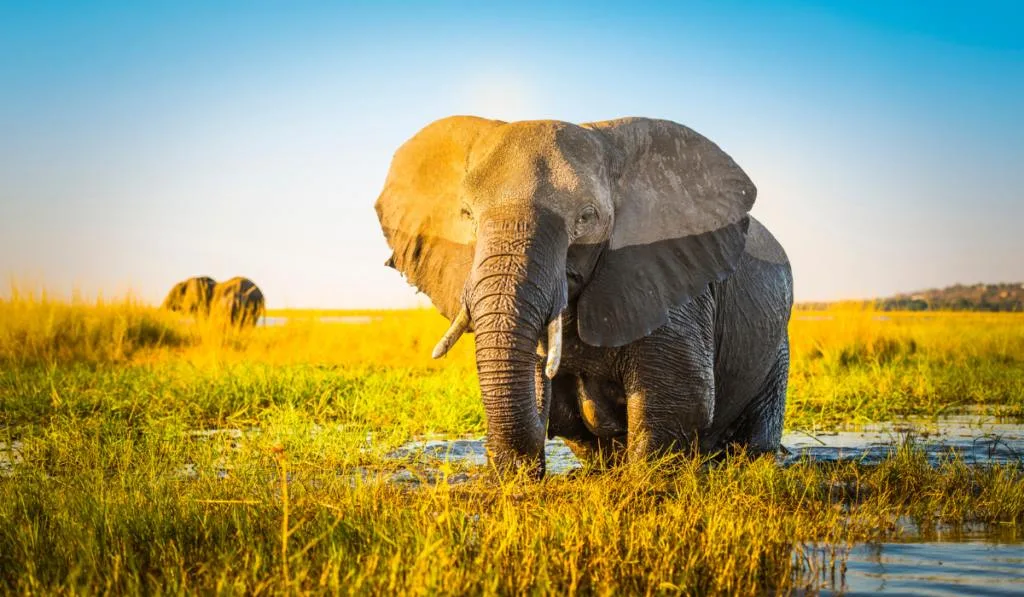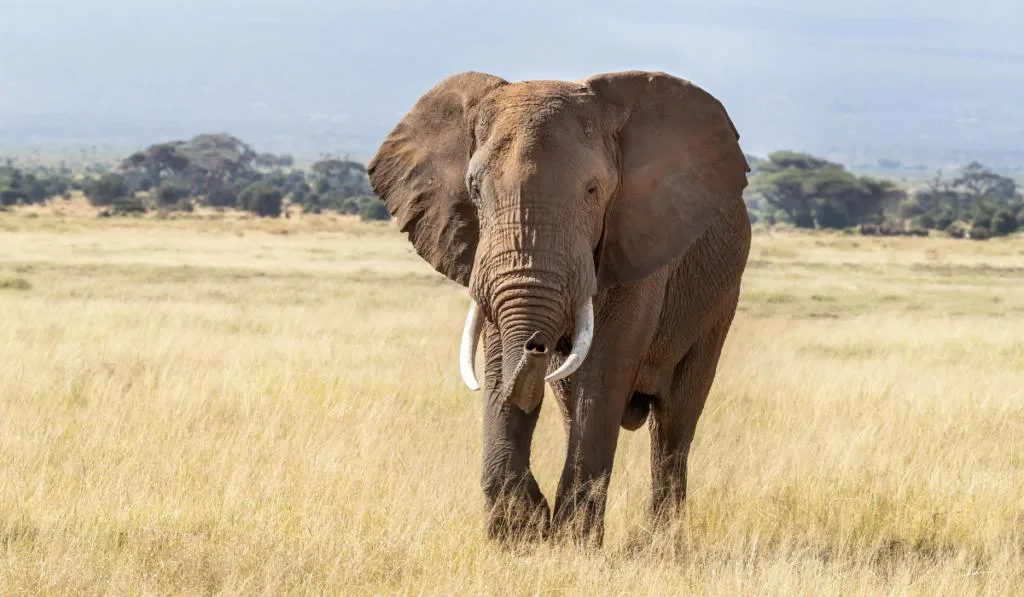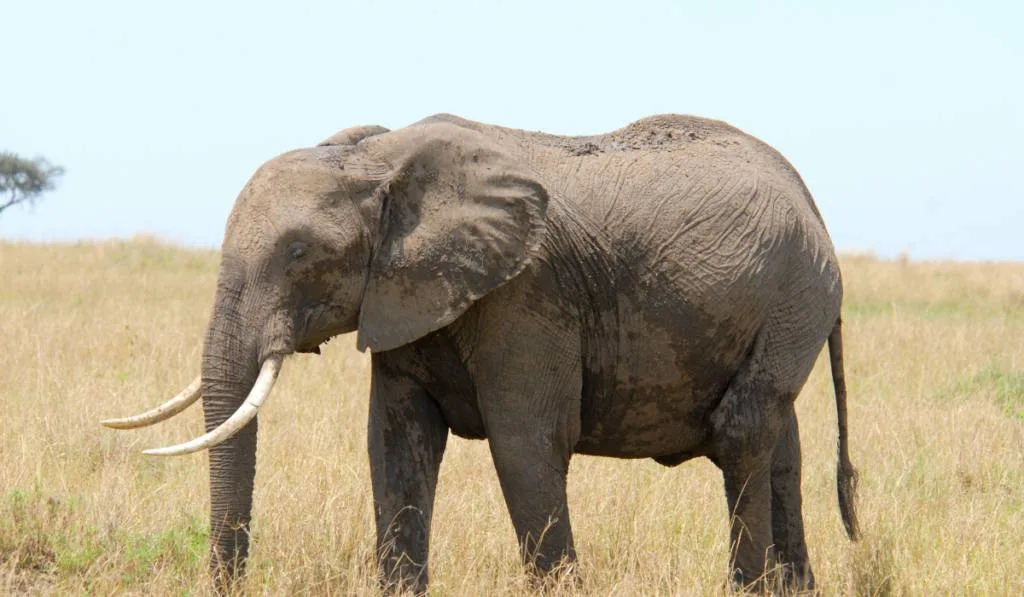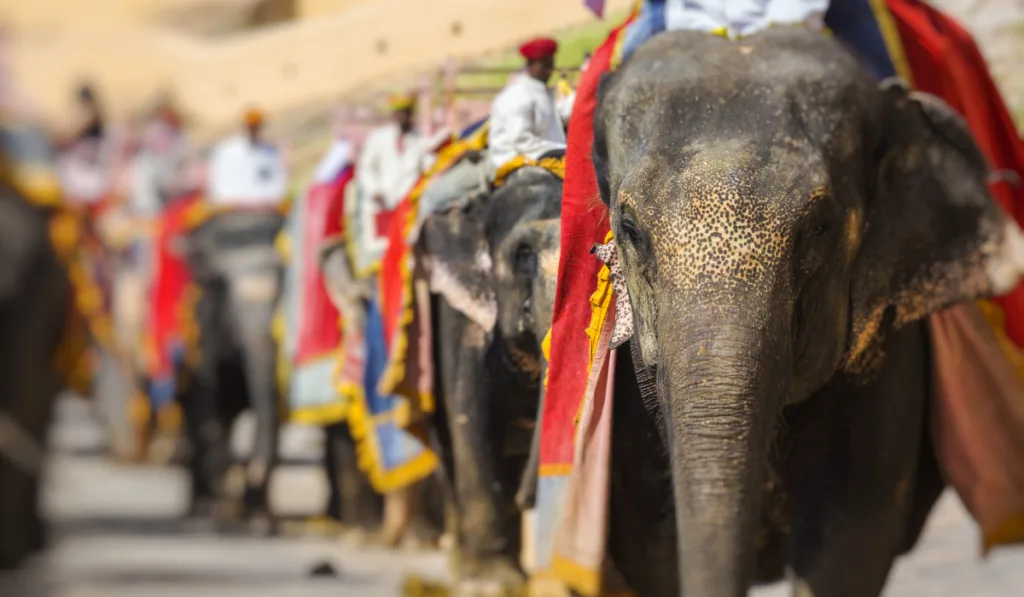Look anywhere on land and you will not find any animal larger than an elephant. Besides being the largest terrestrial animal, they are also one of the largest mammals known to have existed.
When you see an elephant of any species, you will find the usual, well-known features: four legs, a trunk, tusks, a tail, and large ears. But you will find that certain aspects of these features may differ from one type of elephant to another.
There are currently three main types, or species, of elephants in the world: African Bush elephants, African forest elephants, and Asian elephants. At the same time, there are about thirty-five elephant species that have gone into extinction.
This article focuses mainly on the current elephants we know and love but will mention the extinct species for reference later on.

Table of Contents
Types of Elephants
As with many other living things, current elephants evolved from common ancestral elephants. As nature would have it, many of those ancestral elephants are now extinct.
In fact, there are only three species of elephants still in existence. They are African Bush elephants, African forest elephants, and Asian elephants.
These three species belong to two genera: Africa elephant and Eurasian elephant.
This section will be in two parts: one for current elephants and one for extinct elephants.
3 Types of Elephants
African Elephants

African elephants are the largest species of elephants in the world. They have an estimated total population of around 415,000 individuals.
There are two species of African elephants: the African Bush elephant and the African Forest elephant. The African Bush elephant species has two subspecies. But one of them, the North African elephant, is now extinct.
The African elephants generally live in tropical forests, savannas, grasslands, and woodlands.
They can be found in Western and Central African countries, including the Democratic Republic of the Congo.
African Bush Elephant
The African Bush elephant can be found in habitats such as dry savannahs, deserts, and lakeshores. They are mainly found in Sub-Saharan Africa in countries such as Malawi and Gabon.
African Bush elephants present with large ears, large tusks (between 9-10 feet long), and very wrinkled skin.
African Bush elephants are the largest terrestrial animal in the world. The males are typically 10-13 feet tall with a body mass of 5.2-6.9 tons. The females stand at 8-9 feet tall with a body mass of 2.6-3.5 tons.
The current population of African Bush elephants is around 300,000.
Individual forest and savanna populations are yet to be reported by the International Union for Conservation of Nature (IUCN).
As a result, further research is being carried out. The union currently lists the African Bush elephant as vulnerable.
On average, African Bush elephants live for up to 60-70 years in the wild. But those in the zoo may fall short of this average significantly.
African Bush elephants are herbivorous. They feed on leaves, fruits, stems, bark, grass, and much more, and in a day, they need to consume around 350 pounds of vegetation.
This species of elephants has a gestation period of 20-24 months. They typically give birth to one calf. But in some rare cases, they may have twins.
African Forest Elephant

The African Forest elephant is mainly found in equatorial forests. They may also be found in ecotones between forests and savannahs.
African Forest elephants are around 8-10 feet tall and weigh 3.3-6.6 tons. Like their African Bush counterparts, African Forest elephants live for 60-70 years in the wild. But they may also not live as long in a zoo setting.
African Forest elephants also feed on vegetation, and the average adult needs about 300 pounds of food per day.
Members of this species reach sexual maturity at age 23. The gestation period of a pregnant African Forest elephant lasts 22-24 months.
They are said to have the slowest reproductive rate amongst the three African elephant species.
The population of the African Forest elephant has declined by at least 62% in the past 10 years. For obvious reasons, they are currently listed as vulnerable by the IUCN.
It is thought that the current population of the African Forest Elephants stands at less than 100,000.
Eurasian Elephants
Asian Elephant

The Asian elephant prefers habitats that have a combination of grasses and low woody plants. In other words, they fancy inhabiting tropical forest habitats. Such areas include dry thorn scrub forests. Asian elephants are also found in rain forests.
The Asian elephant is commonly found in South and Southeast Asia in India, Nepal, and Sri-Lanka.
This species of elephants is reported to have three subspecies: the Indian elephant, the Sri Lankan elephant, and the Sumatran elephant.
Asian elephants are generally smaller than African elephants. Compared to their African counterparts, they have little or no wrinkles.
The back of Asian elephants is either convex or level, and their trunks have only one extension Also, compared to the African elephants, they have better muscle coordination.
All Asian elephant subspecies are endangered according to the IUCN.
The total population ranges from about 25,600 to 32,750 individuals.
While in the wild, you can expect an Asian elephant to for about 41 years. As with other species, they may not live this long in a zoo.
Sri Lankan Elephant

Sri Lankan elephants stand about 8-10 feet tall with weights ranging from 2.2-6 tons. They are the largest subspecies amongst the Asian Elephant species.
Sri Lankan elephants are commonly seen in Sri Lanka and on a tear-shaped island around India’s southern tip. They fancy living in forests, marshes, open grasslands, and lakeshores.
The Sri Lankan elephants are endangered. Their population is estimated to be around 3,160-4,400.
For this reason, Sri Lankan law has outlawed the killing of this species. According to this law, killing a Sri Lankan elephant invokes the death penalty.
Sri Lankan elephants commonly eat as much as 10% of their body mass in a day. On average, this equals 300 pounds of vegetation every day.
They have a gestation period of 22 months, and they typically give birth to a single 200-300 pound calf. Sri Lankan elephants can live for up to 70 years.
Indian Elephant

Indian elephants weigh around 5 tons, grow as tall as 6-11 feet, and as long as 21 feet. They commonly live in forests and grasslands.
Indian elephants are the most widely distributed subspecies of Asian elephants. You’ll find them in up to eleven Asian countries, including Laos, Cambodia, Malaysia, China, Pakistan, Nepal, and Vietnam.
They also have the highest population amongst Asiatic elephants, with about 20,000 and 25,000 individuals.
Indian elephants also eat as much as 300 pounds per day, and they have a gestation period of 18-22 months. They live for about 48 years.
Sumatran Elephant

Sumatran elephants have average heights of 5-9 feet and lengths of up to 20 feet. They weigh about 5 tons and are typically found in moist tropical forests.
This species is located only on the island of Sumatra, Indonesia. Hence, the name.
While they are the largest terrestrial animal in Indonesia, Sumatran elephants are relatively smaller than other Asian elephants.
The species is endangered, and its population currently stands between 2,400-2,800.
Sumatran elephants eat over 100 species of vegetation. On average, they need about 330 pounds of food and 52 gallons of water a day.
They live for 60-70 years but can go on as far as 75 years. The gestation period in Sumatran elephants is 18-22 months, and by age 60, female Sumatran elephants have stopped reproducing.
Extinct Elephants
Modern-day elephants are descendants of some of the largest mammals to have roamed the earth. The following is a list of some genera and common names of elephants that used to exist:

- Amebelodon
- The American Mastodon
- Anancus
- Barytherium
- Cuvieronius
- Deinotherium
- The Dwarf elephant
- The Straight-Tusked elephant
- The Woolly Mammoth
- Tetralophodon
- Stegotetrabelodon
Can Elephant Types Crossbreed?
Unlike their ancestors, the current elephant species rarely ever crossbreed. In fact, there has been only one such occurrence.
In Chester Zoo 1978, an elephant calf with a female Asian elephant and a male African Bush elephant was delivered. This bull calf was named Motty, and it had the features of African Bush elephants and Asian elephants.
Despite the intensive nursing care received, Motty died two weeks after birth. He had stomach issues and did not survive.
Before Motty was delivered, crossbreeding between elephants was considered impossible.
Considering that both species have a similar number of chromosomes, there seems to be no evidence why the elephants rarely crossbreed.
Resources
- https://www.atheritagehouse.com/types-of-elephants/#more
- https://www.britannica.com/animal/elephant-mammal
- https://www.nationalgeographic.com/animals/mammals/a/african-elephant/
- https://en.upali.ch/differences-between-african-and-asian-elephant/
- https://seaworld.org/animals/all-about/elephants/habitat/
- https://www.thoughtco.com/prehistoric-elephant-pictures-and-profiles-4043331
- https://www.nature.org/en-us/get-involved/how-to-help/animals-we-protect/african-bush-elephant
- https://www.awf.org/wildlife-conservation/forest-elephant
- https://www.nytimes.com/2012/12/27/world/africa/in-gabon-lure-of-ivory-proves-hard-to-resist.html
- https://www.nature.org/en-us/get-involved/how-to-help/animals-we-protect/african-bush-elephant/
- http://animalia.bio/sri-lankan-elephant
- https://www.worldwildlife.org/species/sri-lankan-elephant
- https://a-z-animals.com/animals/sri-lankan-elephant
- https://animals.net/indian-elephant/
- https://www.researchgate.net/publication/307866470_BEHAVIORAL_CHARACTERISTICS_OF_SRI_LANKAN_ELEPHANTS
- https://wwf.panda.org/knowledge_hub/endangered_species/elephants/asian_elephants
- https://www.worldwildlife.org/species/indian-elephant
- http://www.fao.org/3/ad031e/ad031e0a.htm
- https://a-z-animals.com/animals/sumatran-elephant
- https://www.worldwildlife.org/species/sumatran-elephant
- https://www.elephant.se/Motty_the_elephant_crossbreed.php
